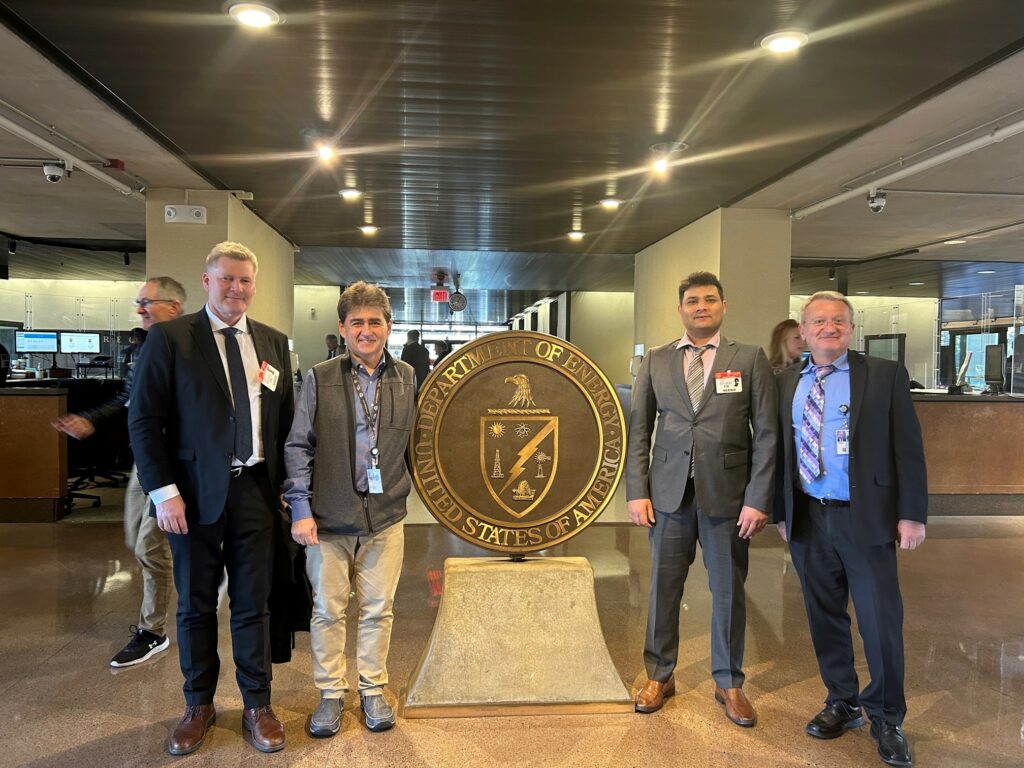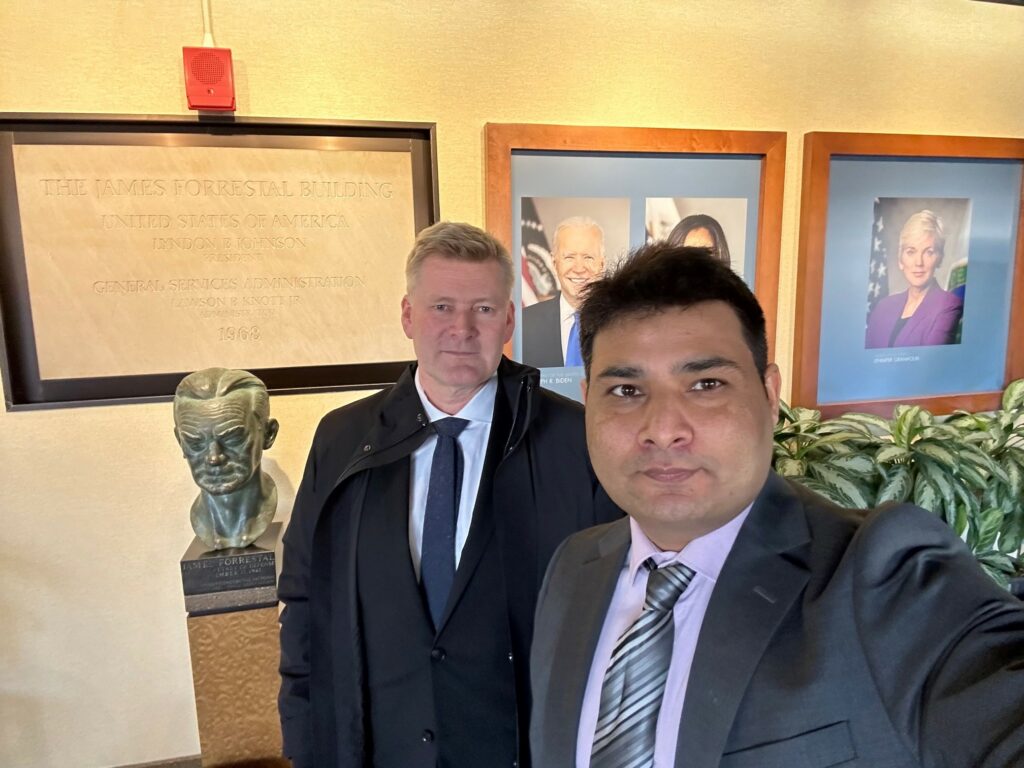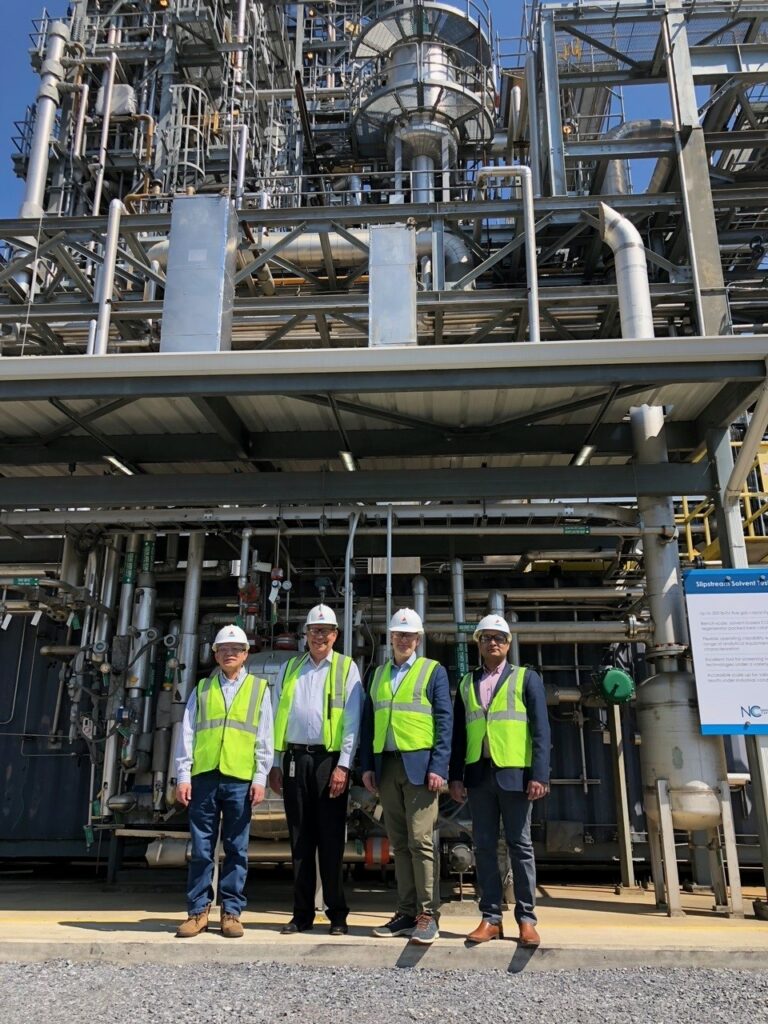31.03.2023
Will further develop cooperation with the United States
“Norway and the United States have a common goal to make technology for capturing CO2 available to industry worldwide.
A number of American companies have tested technologies at TCM, and the meetings we had in the Department of Energy (DoE) and at the National Carbon Capture Center (NCCC) confirmed to us that they are very interested in developing this collaboration.

At the US Department of Energy, Svein Ingar Semb (left) and Muhammad Ismail Shah (3rd from left) were welcomed by Dan Hancu and Andrew H. Lasko.
TCM’s Managing Director, Muhammad Ismail Shah, and Chairman, Svein Ingar Semb, went on a one-week trip “across the pond” in March to discuss possible projects for further collaboration with representatives of the US authorities and central CCS actors.
“The timing of our visit was good, because the Biden administration, through the Inflation Reduction Act (IRA), is providing for large-scale investment in carbon capture and storage in order to reach its climate goals. Back in 2009, Norway and the USA signed an MoU (Memorandum of Understanding) on cooperation in the energy field, in which CCS projects are highlighted as an important area of work. We have been largely successful in this – among other things, TCM has facilitated test campaigns for commercial suppliers and for technology development under the auspices of research-based institutions. So we have a good basis for developing cooperation within TCM’s core business.”
Good meetings in the Department of Energy
At the DoE meetings, Shah and Semb met with the leadership team in the Office of Fossil Energy and Carbon Management (FECM) and the Office of Clean Energy Demonstrations (OCED). FECM has been contributing funding for several years to the development of capture technologies at TRL (Technology Readiness Level) 6, several of which have been tested at TCM to scale up to TRL 7.
“Their feedback is that this collaboration has worked well, and that the testing at our facilities and the expertise we offer provide value for money. They want to work more closely with us, not least to strengthen knowledge about emissions where amine-based technologies are used. We will be notified when they have completed the process of planning their upcoming testing activities, and we were also invited to present the findings from our open test campaigns at a conference in August,” Shah says.
The task of OCED is to demonstrate full-scale capture and storage of CO2 at six different demo plants with technologies at TRL 7 and higher. “OCED is a new office which was established last autumn. TCM has not been in discussions with representatives from this office before, and it was useful to establish a relationship and talk about what we can offer by way of opportunities and services, which can help them succeed with their demo projects.”

Svein Ingar Semb (left) and Muhammad Ismail Shah in the James Forrestal Building.
At the NCCC in Alabama
From the ministry offices in Washington, Shah and Semb went on to the small town of Wilsonville in Alabama, which is the location of the National Carbon Capture Center. This testing centre is financed by the US government through the DoE and industrial players, including TotalEnergies, the Electric Power Research Institute (EPRI) and others. The NCCC has approx. 100 employees and the level of activity is high.
“For the authorities, the NCCC is a central instrument for driving forward the development of new capture technologies. But the facility is smaller than TCM and technologies being tested have a lower maturity level (TRL 6). In other words, TCM allows the Americans to test and verify technologies in physical environments that are a notch closer to full-scale capture. But for both parties, closer cooperation and exchange of knowledge can provide significant benefits in accelerating the scale-up of carbon capture technologies.”
Great interest in the Longship project
Svein Ingar Semb says that they talked about developments in the Longship project both during the meetings in Washington and at the NCCC.
“The fact that little Norway is now realising a fully-fledged value chain for capture and storage of CO2 is viewed with great interest and is gaining recognition. When the Americans eventually make plans for projects on the same scale, learning from Longship will probably be used. This would include regulatory matters relating to the transport of CO2 across national borders, where similar issues could arise for transport between states. In sum, we have a lot to learn from each other and to collaborate on, both in the development of cost-effective capture technologies and in the realisation of CCS projects that the world needs.”

On a tour of the National Carbon Capture Center. From the left: Tony Wu, Frank Morton, Svein Ingar Semb and Muhammad Ismail Shah.
